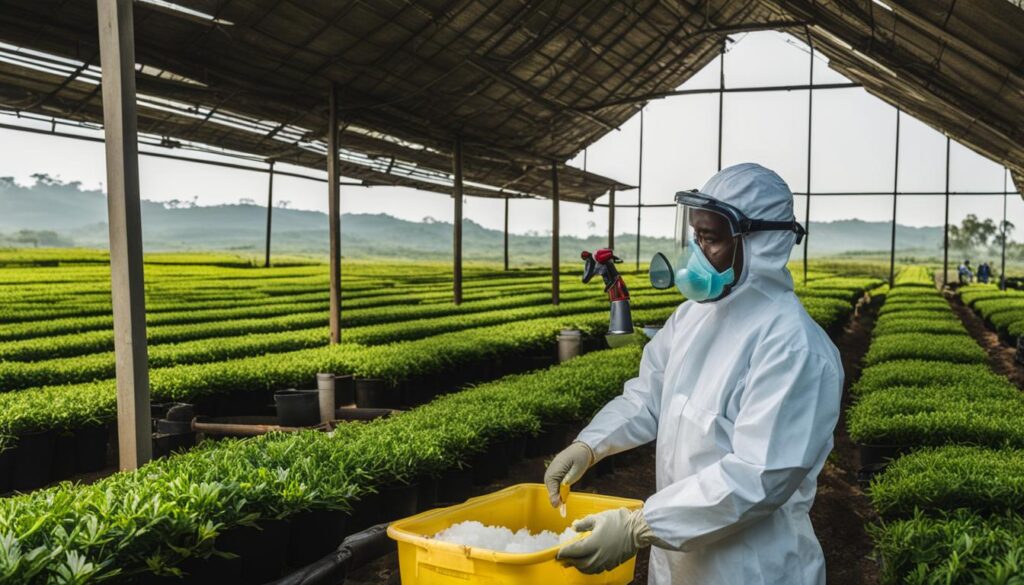
Labor Management in Tea Cultivation: Effective Strategies
Greetings tea enthusiasts! Today, we delve into the world of tea cultivation and explore the importance of labor management in this thriving industry. From carefully nurturing tea leaves to crafting our favorite brews, managing the labor behind the scenes is no easy task. Join us as we uncover effective strategies to optimize productivity and ensure the well-being of our hardworking tea plantation workforce.
Key Takeaways:
- Tea farmers must prioritize fair wages, better housing options, and work-life balance for their labor force.
- Managing labor in organic tea farms requires adherence to stringent standards and protocols.
- Worker safety, welfare, and labor rights should be a top priority.
- Workforce planning, training programs, and productivity measures are essential for labor efficiency.
- Addressing these challenges and implementing effective labor management strategies leads to sustainable growth in the tea cultivation industry.
Challenges in Tea Cultivation Labor Management
Tea farmers face several challenges in managing labor in their cultivation operations. One major challenge is the optimization of labor costs while still ensuring fair wages for workers. It is essential to find the right balance between labor efficiency and labor rights to create a harmonious working environment. This involves implementing strategies that maximize productivity while prioritizing the well-being of the labor force.
In addition to cost optimization, tea farmers must also manage labor in organic tea farms. Organic certification requires strict adherence to standards and protocols that ensure the sustainability and purity of the tea. This includes using organic fertilizers, avoiding synthetic pesticides, and implementing eco-friendly practices. Managing labor in organic tea farms involves educating workers about organic farming principles and ensuring compliance with organic certification requirements.
Safety protocols for tea farm workers are crucial to prevent accidents and injuries in the workplace. Tea cultivation involves various manual tasks, such as planting, pruning, and harvesting, which can pose risks. Implementing comprehensive safety measures, such as providing protective gear, conducting regular training sessions, and promoting a safety-first culture, is essential to safeguard the well-being of the labor force.
Table: Challenges in Tea Cultivation Labor Management
| Challenges | Strategies |
|---|---|
| Optimizing labor costs | Finding the right balance between efficiency and fair wages |
| Managing labor in organic tea farms | Adhering to organic certification standards and protocols |
| Ensuring worker safety | Implementing comprehensive safety protocols and training |
Furthermore, tea farmers must prioritize the rights and welfare of their labor force. This involves providing fair treatment, appropriate working conditions, and access to necessary resources and benefits. Proactive measures such as timely payment of wages, healthcare facilities, and opportunities for skills development contribute to the overall well-being and job satisfaction of tea farm workers.
Effectively managing labor in tea cultivation requires a holistic approach that takes into account cost optimization, organic farming principles, worker safety, and labor rights. By addressing these challenges head-on and implementing appropriate strategies, tea farmers can create a conducive working environment that promotes sustainability, productivity, and the overall success of their tea farms.
Strategies for Seasonal Labor Management in Tea Cultivation
Tea cultivation is a dynamic industry that experiences fluctuations in labor demands throughout the year. To effectively manage seasonal labor in tea farms, it is crucial for farmers to develop robust workforce planning strategies. By aligning labor availability with peak periods, such as harvest season, tea farmers can ensure they have an adequate workforce to meet production goals and maintain quality standards.
One approach to tea farm workforce planning is to establish a network of reliable and skilled workers who are available on a seasonal basis. This can be achieved through partnerships with local labor agencies or by maintaining a database of experienced workers who can be called upon when needed. By proactively managing labor availability, tea farmers can avoid shortages during critical periods and minimize disruptions to their operations.
Another aspect of seasonal labor management in tea cultivation is optimizing labor efficiency during the harvesting process. Implementing standardized work processes and providing comprehensive training programs for tea farm workers can significantly improve productivity. By equipping workers with the necessary skills and knowledge, they can perform their tasks more efficiently, leading to higher yields and reduced labor costs.
| Benefits of Effective Seasonal Labor Management |
|---|
| Increased productivity during peak periods |
| Reduced labor costs through improved efficiency |
| Minimized disruptions to farming operations |
| Improved quality control and consistency |
Measuring tea farm labor productivity is essential to identify areas for improvement and implement strategies to enhance overall efficiency. By tracking key metrics such as the amount of tea harvested per worker or per hour, farmers can gain valuable insights into operational performance. This data can then be used to implement targeted initiatives to increase productivity and optimize resource allocation.
In summary, effective seasonal labor management is vital for tea farmers to meet the demands of the industry and maximize productivity. By implementing robust workforce planning strategies, optimizing labor efficiency, and measuring productivity, tea farmers can ensure they have the right workforce at the right time, improve operational performance, and drive sustainable growth in the tea cultivation sector.
Ensuring Worker Safety and Welfare in Tea Farms
Ensuring the safety and welfare of tea farm workers is of paramount importance to us. We have implemented comprehensive worker safety protocols to create a secure work environment and prevent accidents. Our safety procedures include regular training sessions to educate our workers on industry best practices and the proper use of equipment. By prioritizing safety, we aim to protect the well-being of our laborers and promote a culture of care and responsibility.
Managing labor in organic tea farms is another key aspect of our operations. We adhere to strict organic standards and protocols to maintain the integrity of our certification. This includes using natural pest control methods and organic fertilizers to minimize the use of chemicals. By cultivating tea in an organic and sustainable manner, we not only protect the health of our workers but also contribute to the preservation of the environment.
“At our tea farms, we believe in the importance of upholding labor rights and welfare. We ensure fair treatment for our workers, timely payment of wages, access to healthcare facilities, and other essential benefits. By providing a supportive and inclusive work environment, we aim to create a motivated and loyal workforce.”
Tea Farm Worker Rights and Welfare
At our tea farms, we prioritize the rights and welfare of our labor force. We recognize the importance of fair treatment and ensure that our workers are treated with dignity and respect. By providing decent wages and working conditions, we aim to improve the overall well-being of our employees. We value their contributions and believe that a satisfied workforce is essential for the success of our tea cultivation operations.
| Worker Benefits | Worker Rights |
|---|---|
| Access to healthcare facilities | Right to fair wages |
| Provision of housing and sanitation facilities | Right to safe working conditions |
| Opportunities for skills development and training | Right to rest and leisure time |
By aligning our labor management practices with these core principles, we strive to create a positive and empowering work environment. Our commitment to worker safety, welfare, and rights reflects our dedication to building a sustainable and socially responsible tea cultivation industry.

Improving Labor Efficiency in Tea Cultivation
Improving labor efficiency in tea cultivation is essential for tea farmers to optimize productivity and reduce operational costs. By implementing targeted strategies to improve labor efficiency, tea farmers can maximize their yield and profitability. One effective strategy is the implementation of tea farm worker training programs. These programs aim to enhance the skills and knowledge of tea farm workers, enabling them to perform tasks such as planting, pruning, and harvesting more efficiently.
“By providing proper training programs for tea farm workers, we can empower them with the necessary skills and knowledge to excel in their roles. This not only increases labor efficiency but also boosts worker confidence and satisfaction.”
Furthermore, tea farm labor productivity measures can be implemented to track and analyze the efficiency of labor in tea cultivation. Farmers can measure the amount of tea harvested per worker or per hour, enabling them to identify areas where efficiency can be improved. This data-driven approach allows farmers to make informed decisions and implement strategies that enhance labor productivity.
Benefits of Improving Labor Efficiency
Improving labor efficiency in tea cultivation offers numerous benefits for tea farmers. Firstly, it allows farmers to increase their overall productivity, resulting in higher yields and greater profitability. Additionally, enhanced labor efficiency reduces operational costs, as fewer resources are required to achieve the same level of output. This can contribute to the long-term sustainability and success of tea farms.
“Improving labor efficiency not only benefits tea farmers but also has a positive impact on the overall quality of our products. When our workers are skilled, motivated, and efficient, it reflects in the final product, resulting in higher customer satisfaction.”
By focusing on labor efficiency and implementing strategies such as training programs and productivity measures, tea farmers can create a more productive and sustainable tea cultivation industry.

Conclusion
Effectively managing labor in tea cultivation is essential for the success of tea farms. By prioritizing fair wages, worker safety, and welfare, tea farmers can create a positive working environment that attracts and retains skilled laborers. Our commitment to fair compensation ensures that our workers feel valued and motivated to contribute to the growth of our tea farm.
Implementing labor management strategies, such as workforce planning and training programs, can enhance labor efficiency and productivity. We believe in investing in our workforce through continuous training and development, empowering them with the skills and knowledge they need to excel in their roles. By providing our workers with the tools they need to succeed, we are able to maximize productivity and drive sustainable growth.
Additionally, we understand the importance of adhering to labor rights and regulations. Our commitment to treating our workforce with fairness and respect is unwavering. We believe in providing a safe and supportive work environment that promotes the well-being of our workers. By upholding labor rights and regulations, we ensure that our workforce is protected and can thrive in their roles.
By addressing these challenges and implementing effective labor management strategies, tea farmers can achieve sustainable growth and success in the tea cultivation industry. Our dedication to optimizing labor management enables us to overcome obstacles and seize opportunities for growth. We are proud to be a part of the thriving tea cultivation industry and will continue to strive for excellence in all aspects of our labor management practices.
FAQ
What are the major challenges faced in labor management in tea cultivation?
The major challenges in labor management in tea cultivation include optimizing labor costs while ensuring fair wages, managing labor in organic tea farms, implementing safety protocols, and prioritizing the rights and welfare of tea farm workers.
How do tea farmers manage seasonal labor fluctuations in tea cultivation?
Tea farmers manage seasonal labor fluctuations by developing effective workforce planning strategies to ensure they have sufficient labor during peak periods, implementing standardized work processes, and optimizing labor efficiency through training programs.
How do tea farmers ensure the safety and welfare of tea farm workers?
Tea farmers ensure the safety and welfare of tea farm workers by implementing comprehensive worker safety protocols, providing training on safety procedures, maintaining proper equipment, conducting regular safety inspections, and adhering to strict standards in organic tea farms.
How can labor efficiency be improved in tea cultivation?
Labor efficiency in tea cultivation can be improved through training programs that enhance the skills and knowledge of tea farm workers, implementing strategies to increase productivity, and measuring tea farm labor productivity to identify areas for improvement.
Source Links
- https://jiffygroup.com/news-overview/navigating-challenges-of-tea-cultivation/
- https://ijac.org.uk/labour-in-the-tea-plantation-sector-a-special-reference-to-privatized-large-scale-tea-estates-in-sri-lanka/
- https://www.ilo.org/wcmsp5/groups/public/—asia/—ro-bangkok/—ilo-dhaka/documents/publication/wcms_563692.pdf






